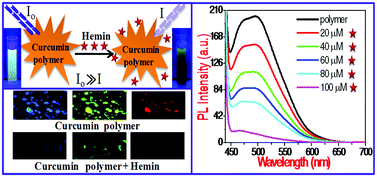Enhanced fluorescence quenching of hemin detected by a novel polymer of curcumin†
Abstract
In this study, a novel

* Corresponding authors
a
Institute of Advanced Study in Science and Technology, Physical Sciences Division, Polymer Section, India
E-mail:
neelot@iasst.gov.in
Fax: +91 361 2279909
Tel: +91 361 2912073
In this study, a novel

 Please wait while we load your content...
Something went wrong. Try again?
Please wait while we load your content...
Something went wrong. Try again?
B. Gogoi and N. S. Sarma, RSC Adv., 2013, 3, 7747 DOI: 10.1039/C3RA40549D
To request permission to reproduce material from this article, please go to the Copyright Clearance Center request page.
If you are an author contributing to an RSC publication, you do not need to request permission provided correct acknowledgement is given.
If you are the author of this article, you do not need to request permission to reproduce figures and diagrams provided correct acknowledgement is given. If you want to reproduce the whole article in a third-party publication (excluding your thesis/dissertation for which permission is not required) please go to the Copyright Clearance Center request page.
Read more about how to correctly acknowledge RSC content.
 Fetching data from CrossRef.
Fetching data from CrossRef.
This may take some time to load.
Loading related content
